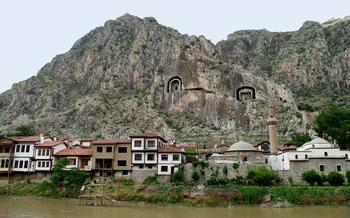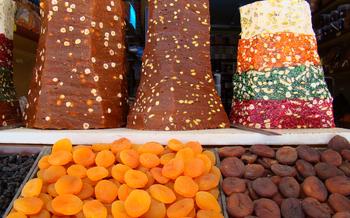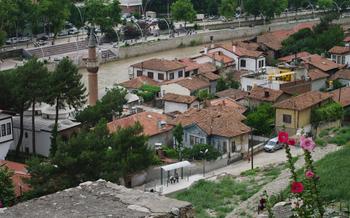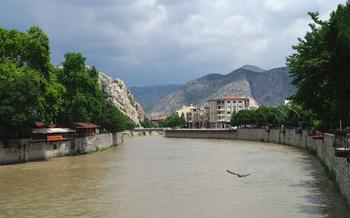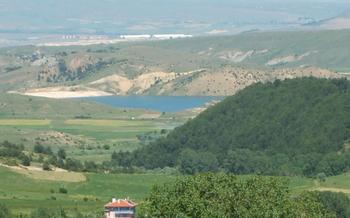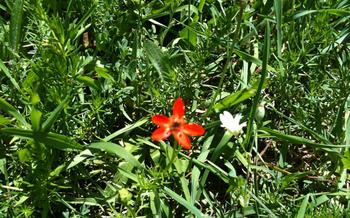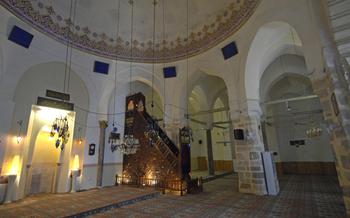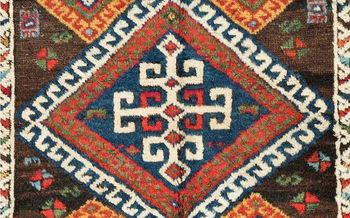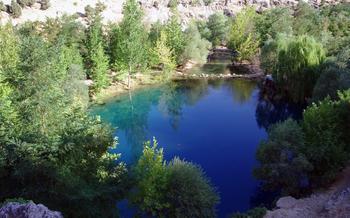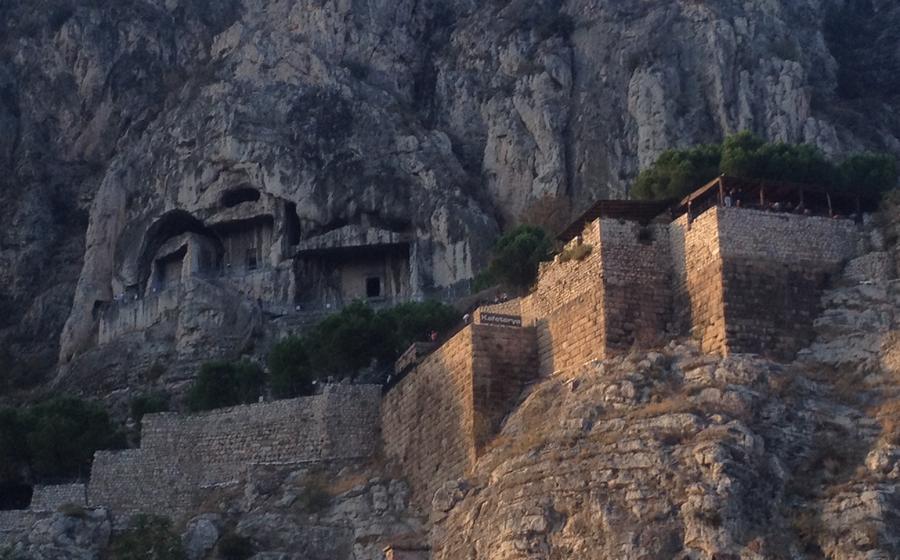
Gökmedrese Mosque
- The Gökmedrese Mosque: A Stunning Masterpiece
- Location and Accessibility
- Exploring the Mosque's Exterior
- Unveiling the Interior's Beauty
- Historical and Cultural Significance
- Photography Tips for Shutterbugs
- Unique Architectural Features
- Nearby Attractions to Explore
- Immersive Experiences for Visitors
- Preservation and Restoration Efforts
- Local Legends and Folklore
- The Gökmedrese Mosque Museum
- Local Handicrafts and Souvenirs
- Insider Tip: Hidden Gems to Discover
The Gökmedrese Mosque: A Stunning Masterpiece
Nestled in the heart of Amasya, the Gökmedrese Mosque stands as a testament to the grandeur and artistry of Seljuk architecture. Built in the 13th century during the reign of Seljuk Sultan II. Gıyaseddin Keyhüsrev, the mosque is renowned for its stunning architectural style, intricate carvings, and lavish interior decorations. It served not only as a place of worship but also as a center of Islamic learning, housing a prestigious theological seminary that attracted scholars and students from across the region. The mosque's enduring legacy as a masterpiece of Seljuk craftsmanship and a symbol of piety continues to attract visitors from around the world, who come to marvel at its architectural beauty and rich historical significance.
Location and Accessibility
The Gökmedrese Mosque is situated in the heart of Amasya, a picturesque city nestled along the banks of the Yeşilırmak River. Its exact address is Gökmedrese Mahallesi, Gökmedrese Sokak No:2, 05100 Merkez/Amasya, Turkey.
The mosque's prime location makes it easily accessible by foot from various points within the city center. Visitors can take a leisurely stroll through the charming streets of Amasya, admiring the historical buildings and vibrant atmosphere, before arriving at the mosque's grand entrance.
For those arriving by car, there are limited parking spaces available in the vicinity of the mosque. Alternatively, visitors can park their vehicles in designated parking areas within walking distance and explore the city center on foot.
The Gökmedrese Mosque is well-connected by public transportation, with multiple bus lines stopping nearby. This provides a convenient and affordable option for visitors who prefer to leave their cars behind and embrace the local transportation system.
Exploring the Mosque's Exterior
As you approach the Gökmedrese Mosque, its grand entrance will captivate your attention. The towering minarets, reaching towards the heavens, symbolize the mosque's stature as a beacon of faith and learning. Take a moment to admire the intricate stonework and decorative elements that adorn the façade, each piece a testament to the skill and artistry of Seljuk craftsmen.
The surrounding courtyard, with its manicured gardens and tranquil atmosphere, invites you to linger and soak in the serenity of the surroundings. Stroll through the courtyard, admiring the architectural details and the interplay of light and shadow. Find a vantage point to capture the mosque's grandeur in all its glory, ensuring that you capture both the sweeping vistas and the intricate details that make this mosque so unique.
Unveiling the Interior's Beauty
Step inside the Gökmedrese Mosque to discover a world of breathtaking beauty and intricate details. The main prayer hall immediately captures the eye with its awe-inspiring dome, a masterpiece of Seljuk architecture. Its intricate patterns and vibrant colors create a sense of grandeur and spirituality. Look closely at the mihrab, the niche indicating the direction of Mecca, adorned with exquisite tilework and calligraphy. The minbar, the elevated pulpit, is another highlight, showcasing the mosque's exceptional craftsmanship. Admire the magnificent calligraphy and Quranic inscriptions that adorn the walls, each letter carefully crafted to convey the sacredness of the space. The mosque's impressive acoustics add to its spiritual ambiance, creating a serene and contemplative atmosphere that encourages reflection and devotion.
Historical and Cultural Significance
The Gökmedrese Mosque holds immense historical and cultural significance, contributing to Amasya's rich heritage as a center of Islamic learning and culture. Built during the 13th century under the patronage of the Seljuk Sultan Alaeddin Keykubad I, the mosque exemplifies the architectural prowess of the Seljuk dynasty, blending Anatolian and Islamic influences. Its construction marked a pivotal moment in the development of Islamic architecture, introducing innovative structural elements and decorative motifs that would shape subsequent Islamic buildings.
The mosque served as a prominent center of Islamic education, housing a theological seminary that attracted scholars and students from across the region. Within its walls, generations of students delved into the study of Islamic law, theology, and philosophy, establishing Amasya as a renowned seat of Islamic knowledge. The mosque's enduring legacy as a place of worship and learning has made it a symbol of Seljuk piety and the enduring spirit of Islamic scholarship.
Beyond its religious and educational significance, the Gökmedrese Mosque showcases the remarkable craftsmanship and artistic achievements of the Seljuk era. Its intricate carvings, tilework, and calligraphy exemplify the high level of artistry and attention to detail that characterized Seljuk architecture. The mosque's construction also reflects the Seljuk's commitment to urban development and their role in shaping the cultural landscape of Anatolia.
As a testament to its historical and cultural significance, the Gökmedrese Mosque has been meticulously preserved and restored over the centuries. Ongoing conservation efforts aim to maintain the mosque's integrity and ensure that its architectural splendor continues to inspire and awe visitors for generations to come. The mosque stands as a living testament to the rich cultural heritage of Turkey and the enduring legacy of Islamic architecture.
Photography Tips for Shutterbugs
For photography enthusiasts, the Gökmedrese Mosque presents a treasure trove of opportunities to capture its architectural grandeur and intricate details. To make the most of your photographic journey, consider the following tips:
-
Golden Hour Magic: Aim to visit the mosque during the golden hours of sunrise or sunset. The warm, diffused light during these times enhances the mosque's colors and textures, creating a captivating ambiance.
-
Composition and Angles: Experiment with different angles and compositions to showcase the mosque's unique features. Capture the towering minarets against the blue sky, highlight the intricate carvings on the entrance, or frame the mosque within the lush greenery of the surrounding gardens.
-
Macro and Detail Shots: Don't just focus on wide-angle shots. Get up close to capture the intricate details of the mosque's tilework, carvings, and calligraphy. These close-up shots will reveal hidden gems and patterns that might otherwise go unnoticed.
-
Respect the Sanctity: While capturing the mosque's beauty, remember to be respectful of its religious significance. Avoid using flash photography during prayer times and be mindful of the worshippers' privacy.
Unique Architectural Features
The Gökmedrese Mosque boasts several unique architectural features that set it apart from other mosques in Turkey. Its innovative structural design, characterized by the use of arches, vaults, and domes, showcases the mosque's advanced engineering skills. The integration of traditional Seljuk and Anatolian architectural elements, such as the pointed arches and intricate stone carvings, adds to the mosque's unique charm. The mosque's construction also demonstrates an understanding of acoustics, with its domed ceiling and strategic placement of windows allowing for optimal sound reverberation during prayers and religious ceremonies. The Gökmedrese Mosque's distinctive architectural features not only make it a stunning masterpiece but also a testament to the creativity and expertise of Seljuk architects and builders. Its influence on subsequent Islamic architecture is evident in many other mosques and religious buildings throughout Turkey and the broader region.
Nearby Attractions to Explore
The Gökmedrese Mosque is just one of the many historical and cultural treasures that Amasya has to offer. Visitors can immerse themselves in the city's rich past by exploring the following nearby attractions:
-
Amasya Castle: This imposing fortress, perched atop a hill overlooking the city, offers stunning panoramic views of Amasya and the surrounding countryside. Explore its ramparts, towers, and dungeons to learn about its role in the defense of the city throughout history.
-
Yeşilırmak River: Amasya is bisected by the scenic Yeşilırmak River, which offers a variety of recreational activities for visitors. Take a leisurely boat ride to admire the city's landmarks from a different perspective, or enjoy a picnic along the riverbanks.
-
Amasya Bazaar: For a taste of local culture and craftsmanship, visit the vibrant Amasya Bazaar. Browse the colorful stalls selling handmade carpets, pottery, jewelry, and other souvenirs. Haggle for the best prices and support the local artisans who keep traditional skills alive.
-
Other Mosques, Museums, and Landmarks: Amasya is home to several other mosques, museums, and landmarks that are worth exploring. Visit the Sultan Bayezid II Mosque, known for its stunning tilework, or the Amasya Museum, which houses a collection of artifacts and exhibits showcasing the city's history and culture.
Immersive Experiences for Visitors
Beyond admiring its architectural splendor, visitors to the Gökmedrese Mosque can immerse themselves in the mosque's spiritual and cultural significance through various immersive experiences. Attending prayers or religious ceremonies at the mosque offers a unique opportunity to witness the devotion and traditions of local worshippers. Engaging with them, visitors can learn about Islamic customs and traditions, fostering intercultural understanding.
The mosque also hosts cultural events and festivals throughout the year, providing visitors with a glimpse into the vibrant cultural heritage of Amasya. These events showcase traditional music, dance, and performances, inviting visitors to actively participate and experience the city's rich cultural tapestry.
Understanding the role of religion in Turkish society is crucial to appreciating the significance of the Gökmedrese Mosque. Visitors can engage with local religious leaders or participate in discussions and workshops to gain insights into Islamic beliefs and practices. This immersive experience fosters mutual respect and understanding, promoting interfaith dialogue and harmony.
Preservation and Restoration Efforts
The Gökmedrese Mosque, with its architectural elegance and historical significance, requires ongoing preservation and restoration efforts to maintain its integrity for future generations. Over the years, the mosque has undergone several restoration projects to ensure its structural stability and preserve its original features. These projects involve careful conservation techniques, such as repairing damaged stonework, restoring intricate carvings, and reinforcing structural elements.
One of the challenges faced by restoration experts is preserving the mosque's historical character while incorporating modern conservation methods. The goal is to maintain the mosque's authenticity and original design elements while ensuring its longevity. Striking a balance between preserving the past and adapting to modern needs is crucial for the mosque's continued survival.
The preservation of the Gökmedrese Mosque is not only a technical endeavor but also a cultural imperative. It represents a commitment to safeguarding Turkey's rich architectural heritage and ensuring that future generations can appreciate and learn from this remarkable monument. The mosque stands as a testament to the enduring power of faith, craftsmanship, and the importance of preserving our cultural treasures.
Local Legends and Folklore
The Gökmedrese Mosque is entwined with local legends and folklore that add to its mystique and cultural significance. One captivating tale is the legend of the "flying mosque." It is said that the mosque was built in a single night by angels who carried it from a distant land. This miraculous origin story highlights the mosque's sacred status and the belief in its divine creation.
Another legend revolves around a pious scholar named Hızır, who is believed to have played a role in the mosque's construction. It is said that Hızır's prayers and devotion moved the mosque from its original location to its current site. These legends have been passed down through generations, shaping the cultural significance of the Gökmedrese Mosque and inspiring local artists and writers to create works of art and literature based on these enchanting stories.
The Gökmedrese Mosque Museum
Within the Gökmedrese Mosque complex, visitors can delve deeper into the history and significance of this remarkable structure by visiting the on-site museum. This museum houses a collection of artifacts, exhibits, and interactive displays that shed light on the mosque's architectural features, religious significance, and cultural impact. Through these exhibits, visitors gain a deeper understanding of the mosque's role in the development of Islamic architecture and its contributions to the rich heritage of Amasya. The museum also provides an educational resource for visitors, allowing them to explore the mosque's intricate details and marvel at the craftsmanship that went into its construction.
Local Handicrafts and Souvenirs
Amasya is renowned for its vibrant handicraft scene, where artisans continue to practice traditional skills passed down through generations. Visitors to the Gökmedrese Mosque can immerse themselves in this rich cultural heritage by exploring the nearby shops and workshops. Here, they can find a treasure trove of handmade souvenirs inspired by the mosque's intricate motifs and designs.
From intricately woven carpets and pottery adorned with vibrant glazes to delicate jewelry and ornate metalwork, there is something for every taste and budget. Visitors can engage with the artisans, learn about their techniques, and gain a deeper appreciation for the craftsmanship that goes into each piece.
By purchasing local handicrafts, visitors not only take home unique souvenirs but also support the preservation of traditional skills and contribute to the local economy. The vibrant colors and patterns of these handmade creations are a testament to the creativity and artistry of the people of Amasya.
Whether it's a hand-woven rug to add warmth and charm to your home, a ceramic bowl intricately painted with mosque-inspired motifs, or a piece of handcrafted jewelry to cherish as a reminder of your travels, Amasya's local handicrafts offer a tangible connection to the city's rich cultural heritage.
Insider Tip: Hidden Gems to Discover
Beyond the main attractions of the Gökmedrese Mosque, there are hidden gems waiting to be discovered by curious travelers. Explore the lesser-known parts of the mosque, such as the tranquil corners of the courtyard, where you can find respite from the crowds and soak in the serene atmosphere. Discover the nearby Gökmedrese Theological Seminary, an important center of Islamic learning that played a crucial role in the mosque's history.
Time your visit to the mosque during sunset, when the golden rays of the setting sun cast a magical glow on the mosque's exterior, creating a breathtaking spectacle. As the sky transitions into a myriad of colors, the mosque's intricate stonework and decorative elements come alive, offering a unique and enchanting experience.
Unveil the city's culinary delights by venturing into local restaurants that serve traditional Turkish cuisine. Savor the flavors of regional dishes, such as the mouthwatering keşkek, a hearty wheat and meat stew, or the tantalizing Amasya kebab, grilled to perfection and infused with local spices. Indulge in the sweetness of Amasya's famous apple desserts, a testament to the region's rich agricultural heritage.
